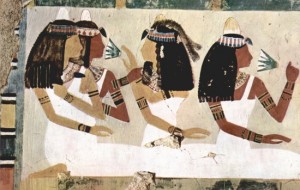Ancient Egyptian Women’s Occupations:
In general, the work of the upper and middle-class woman was limited to the home and the family. This was not due to an inferior legal status but was probably a consequence of her customary role as mother and bearer of children, as well as the public role of the Egyptian husbands and sons who functioned as the executors of the mortuary cults of their deceased parents.

It was customary of the sons to take part in the funeral rites of their parents. Ancient Egyptian Women were not allowed to take part in the funeral rites. Perhaps because it was the males who were regularly entrusted with this important religious task, that they held the primary position in public life.
As far as occupations go, in the textual sources upper-class woman is occasionally described as holding an office, and thus they might have executed real jobs. Clearly, though, this phenomenon was more prevalent in the Old Kingdom than in later periods (perhaps due to the lower population at that time).
One of the most exalted administrative titles of any woman who was not a queen was held by non-royal women named Nebet during the Sixth Dynasty, who was entitled, “Vizier, Judge, and Magistrate.” She was the wife of the nomarch of Coptos and grandmother of King Pepi I.
However, it is possible that the title was merely honorific and granted to her posthumously. Through the length of Egyptian history, we see many titles of women which seem to reflect real administrative authority, including one woman entitled, “Second Prophet (i.e. High Priest) of Amun” at the temple of Karnak, which was, otherwise, a male office.
Ancient Egyptian Women could and did hold male administrative positions in Egypt. However, such cases are few, and thus appear to be the exceptions to tradition. Given the relative scarcity of such, they might reflect extraordinary individuals in unusual circumstances.
Women functioned as leaders, e.g., kings, dowager queens, and regents, even as usurpers of rightful heirs, who were either their step-sons or nephews. We find women as nobility and landed gentry managing both large and small estates.
Women functioned as middle-class housekeepers, servants, field hands, and all manner of skilled workers inside the household and in estate-workshops.
Ancient Egyptian Women could also be national heroines in Egypt. Extraordinary cases include Queen Ahhotep of the early Eighteenth Dynasty. She was renowned for saving Egypt during the wars of liberation against the Hyksos, and she was praised for rallying the Egyptian troops and crushing the rebellion in Upper Egypt at a critical juncture of Egyptian history.
In doing so, she received Egypt’s highest military decoration at least three times, the Order of the Fly. Queen Hatshepsut, as a ruling king, was actually described as going on a military campaign in Nubia. Eyewitness reports actually placed her on the battlefield weighing booty and receiving the homage of defeated rebels.
Royal Women In The Egyptian Kingdom:
In the New Kingdom, the Queen became much more prominent and powerful. She acquired in her own right secular and religious titles that carried with them genuine jobs to do and estates with land, servants, and administrators to provide an independent income.
Emerging out of a period of profound civil unrest, the New Kingdom saw a deliberate attempt to enhance the power and prestige of the monarchy. Perhaps a prominent queen was a part of the technique used by the kings to make themselves more visible from one end of the land to the other.
Egypt sought to establish control over lands that contained people who were not Egyptian. A simple way to demonstrate friendship between two countries was to arrange a marriage between the king of one country and the king’s daughter of another. Royal polygamy made this feasible but increased the need to distinguish between the “real” wife and the ceremonial wives.
Egyptian kings had always had secondary wives, probably to increase the odds of having the all-important son to inherit the throne, but the royal harem was small and discrete and kept very much in the background.
The number of secondary wives increased in the New Kingdom and for the first time, we see the use of the expression “King’s Great Wife” to differentiate between the primary wife and the lesser wives. The famous Egyptian queen was Cleopatra.
The Ancient Egyptian Women were given freedom and liberty which no other civilization gave. They were given equal status at least in theory and this speaks volume of their attitude towards the woman.
